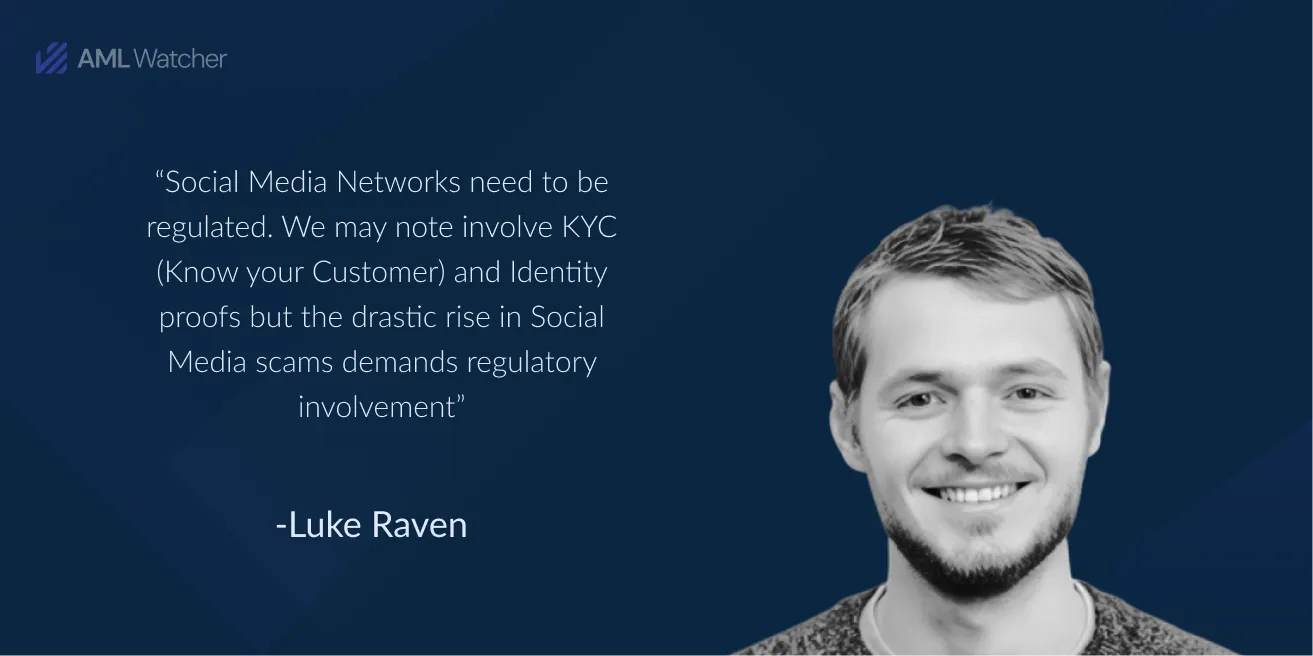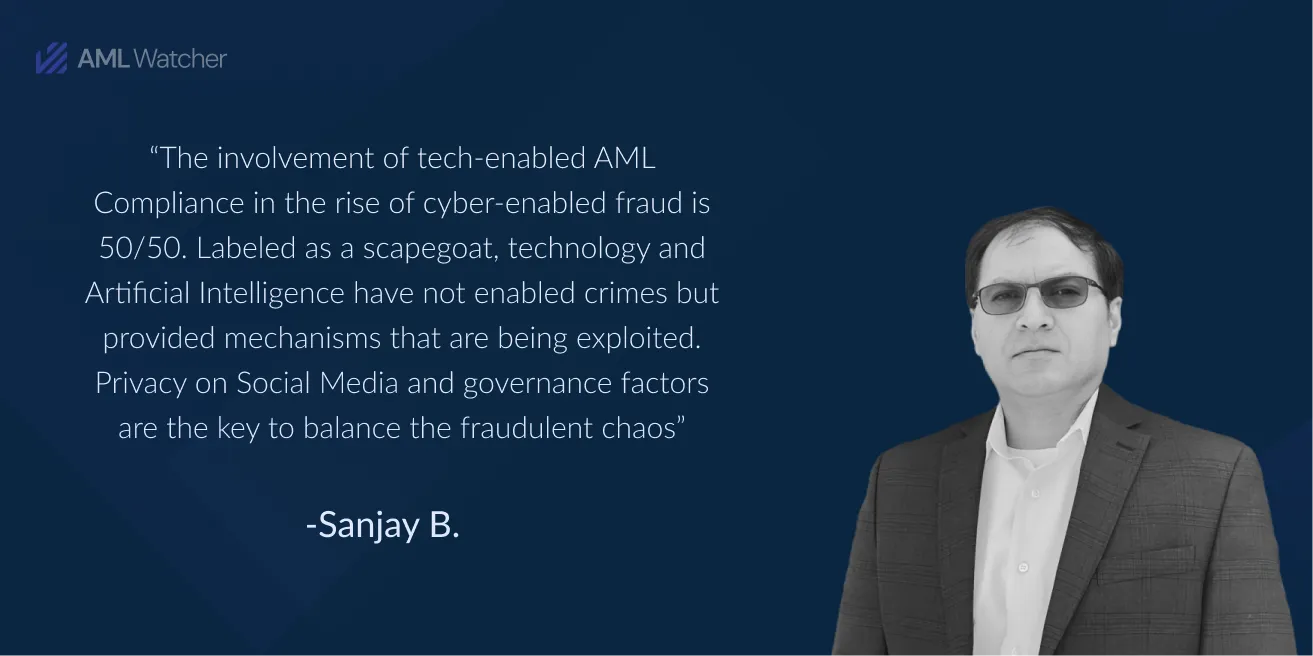
Does Lack Of Cyber Security Facilitate Fraud and Money Laundering?
When I say prevalent frauds with motives to disguise the origin of illicit funds are more like birds of a feather, it is difficult to decide what is enabling what.
Contributing to a trillion-dollar industry, fraud detection and anti-money laundering controls cost businesses around $8.2 billion in 2017, as reported by the World Economic Forum in 2018.
However, it would be unfair not to mention the role of cybersecurity threats facilitating money laundering and enabling fraud as digital advancements are all over the place.
The cost of financial crimes is higher than the loss itself whether institutions allow it to happen or devise ways to prevent them.
To address the alarming concerns of fraud detection and prevention and money laundering fueled by cybersecurity threats, AML Watcher hosted an eye-opening webinar on June 21st, 2024, highlighting the addressable.
In light of the hosted event, this blog will cover topics that no one is ready to talk about unless it’s their turn to face consequences.
- How social media is providing ample space to promote fraudulent activities while demanding it to be regulated with stricter laws?
- How does consolidation of AML and data better help institutes combat these two in synergy? Is FRAML framework the answer to it?
- How can AML technology possibly influence cyber fraud and find an intricate balance between compliance vulnerabilities and AML systems?
Before scooping out the depth of cybersecurity and its potential to accelerate fraud and money laundering, let’s take a look at the latest stats of fraudulent activities causing instability in global economies.
Getting back to addressing the first concern raised in the Webinar;
Dark Side of Social Media & Escalating Financial Crimes
The unbridled urge to open social media, first thing after waking up is real. We might regulate the need if we knew that financial losses of over $2.7 billion have been recorded since 2021, thanks to scams and data breaches on social media.
In response to the question raised “Social media is one of the major facilitators of fraud and recruitment of money mules. Do you think due diligence laws should apply to social networking websites as well”? The guests had answers so real that made me wonder if we should use social media platforms at all.
Kennedy Meda, a Market Intelligence Fraud Analyst in the U.S. Securities and Exchange Commission, mentioned as response, the UK’s Online Safety Act 2023 which advises social network providers to introduce systems and mechanisms reducing online scams and ensuring the protection of user’s online presence.
Highlighting the need for more regulated social media networks, Luke Raven, an experienced anti-financial crime professional endorsed the fact that social media scams are drastically increasing demanding a call for action.
Commenting on the sorry state of affairs, Sanjay Bhakta, a Global Head of Cybersecurity & Fraud Solutions at Centific with over 17 years of experience in financial services, directed the audience to the existence of Deep Fakes generated by AI. The creation of fake identities has become so common that in the coming 10 years, AI fraud detection will make it difficult to identify whether it’s a real person or an AI-generated version of scam actors.
When presented with a scenario of whether due diligence should be employed in the notion of ‘Freedom of Speech’, Sanjay added a truthful statement. It might sound controversial but valid in many dimensions that “We ask for the authority to represent who we are while cybersecurity measures demand to identify the person. The concept needs to be vetted”.
Regulated social media networks are the need of the hour, however, one must be mindful of what they are sharing and who they are interacting with on such platforms because a little maintenance goes a long way.
Synergy of Fraud-Detection & Anti-Money Laundering (FRAML)
The infamous Carbanak attacks (2013) caused financial losses of more than $1 billion are convincing enough that collective efforts should be put forward to curb fraud and illicit financial activities.
Many organizations have agreed on the point where fraud and money laundering are handled under the same umbrella, defining it as FRAML. How efficient is the move?
Commenting on the adaptability of FRAML for efficient prevention of financial crimes and fraudulent activities, Sanjay Bhakta had a logical statement. He endorsed the fact that AI & ML (Machine Learning) are helping against this fight while AML vulnerabilities are touching the sky.
However, adding a twist to the concept of FRAML, our other experts Luke Raven and Kennedy Meda had different opinions on the matter.
Is Artificial Intelligence to Blame?
It may be surprising to some but fraud and anti-money laundering are often connected for one simple reason: there’s no one without the other, especially in the context of crime and regulation.
When asked how AML technology could influence cyber fraud, our guests had quite interesting answers.
Sanjay Bhakta in particular answered by saying it’s a 50/50 kind of situation.
“AI hasn’t enabled fraud, but it gave it a mechanism that could be exploited. It’s not about AI, in particular, technology has just evolved overall”. He went on to explain how AI is used as a scapegoat.
He further draws the connection between how we may not be able to detect deep fakes but we do know it’s still there and how that would also apply to money laundering activities. “It’s more of an enabler and a great facilitator for bad actors’ ‘, Sanjay Bhakta added.
Adding to the discussion, Luke Raven went straight to the fact that undoubtedly technology, particularly AI is capable of solving many problems at hand but there’s no harm in accepting that fraudsters are using it better than us.
On the other hand, Kennedy Meda made her point with the bitter truth that organizations are not unified to handle the epidemic while a human error in the controlling system is never reported and addressed, causing loopholes or significant data breaches.
To find a balance between compliance vulnerabilities and AML systems, it is suggested that there must be risk assessment, clear policies and procedures, effective employee training, and robust internal controls.
Top 3 Cybersecurity Threats Facilitating Money Laundering
Sharing the same goals of committing crimes and then hiding the origin of illicit gains fraud and money laundering activities have seen an escalation due to prevailing cybersecurity threats.
After violating a deferred prosecution agreement with the DOJ (Department of Justice) in 2012, MoneyGram International, Inc. was imposed with a fine of $125 million for indifferently facilitating fraudsters in scamming U.S. consumers worth millions of dollars and inadequate AML controls for illicit money transfers.
Followed by ransomware, identity thefts and deep fakes, malware and hacking, technology has been abused by fraud actors for their ulterior motives, including:
Ransomware Threats
Folded to four times in frequency and severity, ransomware attacks have seen a surge compared to stats collected in 2019.
Can we blame technology? Maybe.
Proceeds of ransomware are obscured through virtual currencies (Bitcoin) because of its vagueness and inability to be traced easily. In addition to employing AML/CFT measures, the seizure against ransomware attacks requires close collaboration of cybersecurity and data protection authorities.
Identity Thefts
Revealed in “The Butterfly Effect”, a 2022 report published by the Javelin Strategy & Research, the year witnessed losses of around $43 billion due to identity fraud.
The stats are lower than the previous year ($52 billion) but the events present chain reactions of the evolving cyber landscape badly impacting the AML space.
Hacking and Malware
The number of adults in the U.S. being victimized by identity thefts increased by 50%. At the same time, the financial losses were recorded at around $24 billion in 2021, as revealed by the Javelin Strategy & Research’s annual identity fraud study, “The Virtual Battleground”.
It’s time to dissect the hidden realities behind the conventional phenomenon of AML compliance measures and how fraud and money laundering are being regulated under the same umbrella while cyber threats are adding fuel to the fire.
Cyber Sanctions are new weapons to gain national interests. Learn about how cyber warfare is fueled by cyber sanctions enforcement while aliens’ activity is reported once again.
Key Takeaways
Bound by some constraints, and a lot that can be said, It might take long to uncover extended layers of truths that have been unleashed in the webinar.
But we can definitely wrap our heads around the key takeaways before you sign off.
- FRAML framework can be impactful in curbing fraud and money laundering only when it comes to the collaboration of departments. For AI to fight the complex tactics of fraudsters, a simple yet efficient system needs to be devised.
- Social media networks need to be regulated. More stringent legislation and security measures are required to limit fraudsters from growing through digital platforms.
- The role of technology in enabling crimes is controversial. The mechanisms initially designed to solve problems are being exploited to create new problems.
- The conflict between data privacy laws and AML laws is healthy and somewhat needed to combat financial crimes.
As much as we do not like to accept it, the truth is, “Privacy does not exist, maybe at some point, but not today”, says Kennedy Meda.
The question is how we can bring a balance between protecting user’s privacy while having enough data to spot fraudsters. What’s more important, strict regulations or the employment of systems and tools that are accessible, simple, and efficient against the fraudsters?
Stream full watch to explore the depths of this debate.
We are here to consult you
Switch to AML Watcher today and reduce your current AML cost by 50% - no questions asked.
- Find right product and pricing for your business
- Get your current solution provider audit & minimise your changeover risk
- Gain expert insights with quick response time to your queries





